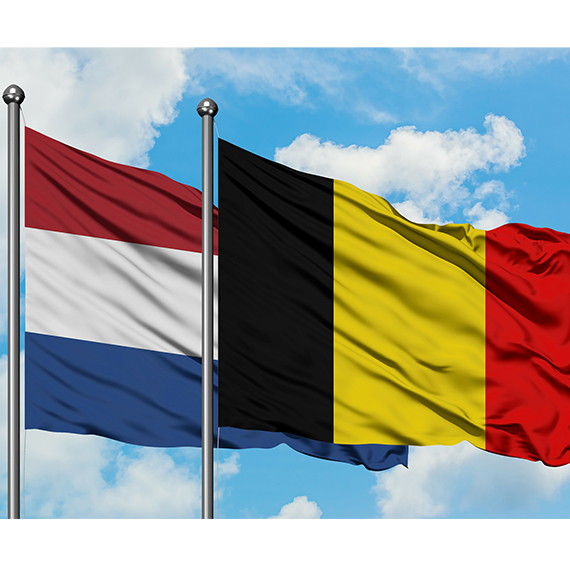At first glance, Dutch used in the Netherlands and in Belgium looks like the same language. After all, there are several similarities. Take another look though, and you'll see there are also many differences – small and large – most notably in the pronunciation but in the vocabulary as well.
In this article, we’ll be looking at those differences that are not immediately obvious.
Where is Dutch spoken?
26 million people speak Dutch worldwide. Most of them live in the Netherlands (17 million) and Belgium (6 million). Beyond that, Dutch is also spoken in the Netherlands Antilles, Suriname, Curaçao, Sint Maarten and Aruba. The language abbreviation for Dutch is “NL".
Which language is spoken in Belgium?
There are three official languages in Belgium:
1. Dutch
2. French
3. German
The language spoken varies according to the region. The Dutch-speaking Flemish live in the "Vlaams Gewest" region. The official language there is Dutch (also called "Flemish" or "Belgian Dutch").
In contrast, "Waals Gewest", the Walloon region – which is often referred to as Wallonia – is home to both French-speaking Walloons and German-speaking Belgians.
Language: the differences between Flemish and Dutch
Belgium and the Netherlands are neighbouring countries. The same language is spoken in Flanders, the Flemish region of Belgium in the north of the country, and in the Netherlands: the Dutch standard language (NL: "Standaardnederlands").
Both the pronunciation and sound of the language are different in these two countries. This is something akin to the difference between High German and Swiss German.
As a rule, Dutch people understand Flemings well, but this is not always the case! Some words are pronounced differently in Flanders, i.e. in the north of Belgium. For example, the word "bikini" is stressed differently in Flanders [bie·kie·nie] than in the Netherlands [bie·kie·nie].1
The Flemish and Dutch also use different terms. For example:
• A dress is called “kleedje” in Flanders, but “jurk” in the Netherlands.
• A cup is “tas” in Flemish, whereas the Dutch say “kopje”.
• A piece of cake? Flemings would ask for “een spie toert”, while Dutch people would order “een stuk taart”.
You'll often find that most Dutch people don't know what's meant by Flemish words. The Flemings, on the other hand, use these terms as a matter of course!
So, if you want to cater to both the Flemish and Dutch markets, you need to be aware of these differences.
Culture: the differences between Belgium and the Netherlands
If you have experience, these linguistic differences are easy to spot. But there’s more. For years now, research has been conducted into the cultural differences between Dutch and Flemish people (e.g. by Prof. Dr. Marinel Gerritsen and Dr. Marie-Thérèse Claes)2. Their findings are important, as they show that cultural differences can also influence communication.
Research by Dutch organisational psychologist Geert Hofstede shows, for example, that Flanders scores higher than the Netherlands in the cultural dimension of uncertainty avoidance3. This means that Flemings prefer to avoid uncertainties and ambiguities as much as possible. Flemings therefore attach great importance to regulations and formalities, which is also noticeable in their trade and commerce.
In comparison to the Flemish, Dutch people are more willing to take a risk4 and are more open to innovation5. Dutch people are also more likely to order online than their southern neighbours, who show a preference for security6.
Compared to the Netherlands, Flanders receives a higher score from Hofstede for the cultural dimension of power distance as well. In the Flemish culture, this is manifested in different ways. A Flemish boss, for instance, is more used to having the last word. In contrast, employees in the Netherlands are generally allowed to express their opinions7.
Tip: watch out for those cultural characteristics!
- As well as giving Christmas presents, the Flemish give New Year's gifts as well!
- Flemish people use the payment method Bancontact and Dutch people use iDEAL8.
- When it comes to sales in Belgium, “Solden” or “Sale” are only allowed twice a year during specific times!
Being on first-name terms in Belgium and the Netherlands
Hierarchies are not that prominent in the Netherlands9. The Dutch are open and usually on a first-name basis, even in business, while the Flemish address each other more formally using surnames10.
Conclusion
When translating into Dutch, our translation team at contact ensures that Dutch and Belgian cultural and linguistic differences are properly reflected.
You too can benefit from our Dutch translators' experience, together with our extensive knowledge and expertise!
Would you like to know more about having your text translated into Dutch?
We will be happy to advise you. Contact us and request a non-binding, informal quotation.
1 http://taal.vrt.be
2 For example: http://taalschrift.org
3 Source: Hofstede, Geert (1995). Title: Cultures and Organizations: Software of the Mind
Intercultural Cooperation and its Importance for Survival
NL: [Allemaal andersdenkenden: omgaan met cultuurverschillen]. Amsterdam: Contact.
4 Source: Hofstede, Geert (1995). Title: Cultures and Organizations: Software of the Mind
Intercultural Cooperation and its Importance for Survival
NL: [Allemaal andersdenkenden: omgaan met cultuurverschillen]. Amsterdam: Contact.
5 Source: https://www.globalinnovationindex.org/analysis-indicator
6 Source: http://ec.europa.eu/eurostat/documents/2995521/7103356/4-11122015-AP-EN.pdf/276b6a7c-69a6-45ce-b6bf-488e975a8f5d; https://www.ecommercewiki.org/;
Hofstede, Geert (1995). Title: Cultures and Organizations: Software of the Mind
Intercultural Cooperation and its Importance for Survival
NL: [Allemaal andersdenkenden: omgaan met cultuurverschillen]. Amsterdam: Contact: https://geert-hofstede.com
7 Source: Hofstede, Geert (1995). Title: Cultures and Organizations: Software of the Mind
Intercultural Cooperation and its Importance for Survival
NL: [Allemaal andersdenkenden: omgaan met cultuurverschillen]. Amsterdam: Contact; https://geert-hofstede.com
8 Source: https://www.ccv.nl/
9 https://geert-hofstede.com/
10 For example: http://taalschrift.org/
